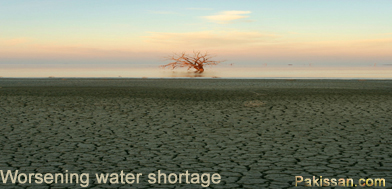Worsening water shortage
By
Dr Ahmad Saeed Bhatti
 The
United Nations Conference on Environment and Development (UNCED)
held at Rio de Janeiro, Brazil, in 1992, declared March 22
as the World Water Day.
The
United Nations Conference on Environment and Development (UNCED)
held at Rio de Janeiro, Brazil, in 1992, declared March 22
as the World Water Day.
The day is celebrated to
mark the implementation of the UN recommendations (Earth
Summit Agenda 21), i.e. to work out proposals and arrange
activities to emphasize reduction in wasteful consumption of
resources such as water.
Altogether water - liquid,
solid (ice) and gas on earth (the water planet) - and the
atmosphere is estimated to be 336 million cubic meter;
And given the population of
seven billion people, every person would receive about one
trillion gallon each, if divided equally (Professor Karrie
Lynn Pennington and Thomas V. Cech). It could, therefore, be
no longer a problem.
Although the total volume of
groundwater on earth is small, it is 35 times greater than
the volume of water in all fresh water lakes and rivers of
the world (c.f. Karen Arms).
All rivers are, however, the result of precipitation; be it
Amazon, Mississippi, Nile or the Indus. Nevertheless, as
emphasised at the Ministerial Conference on Water Security
in the Twentieth Century held at The Hague in 2000, there is
a water crisis, and it is the bad management of water that
has caused billions of people and the environment to suffer
alike.
While the countries of former Soviet bloc were considered to
be the most polluted ones, water pollution appears now to
have spread throughout the world. This has, thus, prompted
all stakeholders -the public, NGOs and the civil societies
in various countries - to attempt to save water from
pollution by garbage, industrial effluents and agricultural
runoff.
The public-private
partnership in cleaning the Cuyahoga River (the river had
become so full of garbage that it caught fire in 1969) in
Cleveland, USA, and the management partnership developed by
Wagga Wagga City Council and Charles Sturt University in
Australia, designated as the Global Water Smart City, is a
case in point.
Further, the
industry-environment nexus in Holland indicated a strong
political will to contain industrial effluents for healthier
management of such resources as water.
In 1989, the Dutch Government
adopted a National Environmental Policy Plan (NEPP2) called
the “Green Plan” to identify all major environmental
problems and meet all concerned, i.e. industrialists and
citizen, groups to establish the goals and timeframe for
reduction in pollution.
In the face of yet greater
divide between the developed and developing countries that
the Doha Conference witnessed with the withdrawal of Canada
from the Kyoto Protocol, the above examples may serve as
guidelines for the less developed nations to rely on their
own resources to manage their water systems.
The amount of water needed to
manufacture a product is termed by economists as “virtual
water”. For instance, for one kilogram of coffee,20,000
litres of virtual water is required;whereas, to produce one
kg of paper,one million ton of steel,one megawatt-hour of
electricity and a cotton T- shirt, it is 300, 215,000, 2,000
to 5,000 and 7,000 litres respectively.Thus, by getting
goods manufactured in less developed countries, the
developed countries make big savings in energy and water, in
addition to low labour costs.
Drinking water is recognised
by World Health Organisation (WHO) as the basic right of
human beings. Yet, some global corporations such as Veolia,
a $38 billion company in Paris and Big Water that promised
more than it could in Bolivia, Argentina, Uruguay, India,
Indonesia, Malaysia, Philippines, South Africa and other
countries; and United Water of USA have taken up marketing
of water to serve more than 300 million people in the world
at their cost.
The US and some European
countries consume more water because firstly, by nature they
are gifted with more water per square km of aquifer as
compared to the countries that face a great ground water
shortage; and secondly, they had the vision to plan and
develop reservoirs for the preservation of rain water.
Two striking examples are the
building of dams by US President Theodore Roosevelt during
30s-40s the years of dustbowl and great economic depression,
and the establishment of Corps of Engineers by President
Thomas Jefferson in 1802 to develop a flood control system
and build water reservoirs for irrigation and drinking.
While India has already built
more than a hundred dams on the Indus, Chenab and Jhelum, it
now plans to build additional 30 to 35 large, 135 medium and
3,000 small dams and diversions on these rivers, which would
reduce the surface of water flows in Pakistan by around 33
to 35 million acre feet annually.
While Pakistan is already
facing an acute shortage of water and energy and if deprived
of 34 MAF annually, this would severely destroy its economy.
As the contribution of
agriculture to GDP has decreased to less than 20 percent
from over 50 percent in 1947, owing to a gross diminution in
cultivable land, and/or increased urbanisation and
industrialisation, the population of Pakistan has, on the
contrary, grown to 180 million from 32.5 million in 1947.
Further, Pakistan has over 60
percent of its land degraded, and from a potential of
42,000MW hydel capacity, it harvests a bare 6,500MW only
(Robert Hathaway, Bhumika Muchhala and Michael Kugelman).
Indeed, this points to the
urgency of building the Kalabagh Dam and a number of small
dams (rain water reservoirs) in the country to preserve
water for drinking and energy.
March, 2013
Source:
The Nation